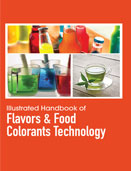Handbooks

Food coloring, or color additive, is any dye, pigment or substance that imparts color when it is added to food or drink. They come in many forms consisting of liquids, powders, gels, and pastes. Food coloring is used both in commercial food production and in domestic cooking. Food colors are prevalent in our daily life and are even in foods and drinks we wouldn?t expect. They are used to make the orange color of oranges brighter and more uniform, to create the brown hues in colas, and blue dye is added to marshmallows to make them, strangely. This process sets a safety limit for food additives to try and ensure no one would eat an unsafe level, even if they ate a large amount of foods containing the color over a lifetime. This illustrated work reviews the natural and synthetic colors available, their properties and applications, in addition to regulatory, sensory and logical issues.
In the distant past, we ate food that was raw or freshly cooked from ingredients that had been caught, grown or foraged. Food additives have been developed over the years to meet the needs of food production, as making foods on a large scale is a very different task to making them in the kitchen at home. Additives are needed to ensure processed food remains in a good condition throughout its journey from the factory to the shop and to the consumer at home. Some are so essential that they are even used in organic foods. Flavorings are intense preparations which are added to foods in order to impart taste and/or smell. These food flavors are used in small amounts and are not intended to be consumed alone. There are certain natural food flavors which are derived from herbs, spices and substances having an exclusively sweet, sour or salt taste. Sometimes, food flavorings are also used to create flavor for food products that do not have desired flavors such as candies and other snacks. Food coloring is used both in commercial food production and in domestic cooking. Food colorants are also used in a variety of non-food applications including cosmetics, pharmaceuticals, home craft projects, and medical devices.
Illustrated Handbook of Flavors & Food Colorants Technology provides coverage of state-of-the-art technologies and future trends in the application of color to food, this book provides the most comprehensive, up-to-date survey of the field. Flavorants are focused on altering or enhancing the flavors of natural food product such as meats and vegetables, or creating flavor for food products that do not have the desired flavors such as candies and other snacks. Most types of flavorants are focused on scent and taste. Few commercial products exist to stimulate the trigeminal senses, since these are sharp, astringent, and typically unpleasant flavors. Artificial flavorants are often formulated with the same chemical compounds found in natural flavorants. Food colors are prevalent in our daily life and are even in foods and drinks we wouldn?t expect. They are used to make the orange color of oranges brighter and more uniform, to create the brown hues in colas, and blue dye is added to marshmallows to make them, strangely, Of course, there are the obvious uses - to decorate a cake or cupcakes, candy and the countless multi-colored foods and drinks we?re so accustomed to seeing. Artificial colors contain various chemicals and are commonly derived from petroleum products. Illustrated Handbook of Flavors & Food Colorants Technology will be of invaluable resource for students? and researchers? in food science, food technology, and nutrition.